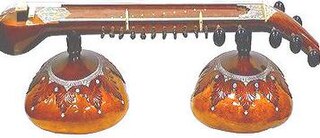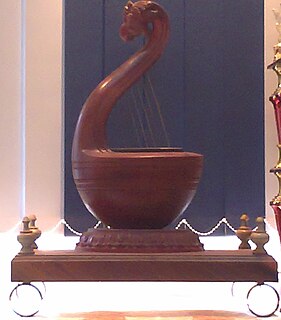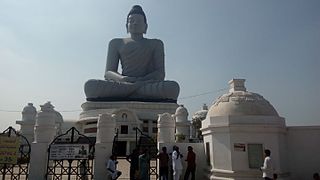
The music of India includes multiple varieties of Punjabi Music, classical music, folk music, filmi, Indian rock, and Indian pop. India's classical music tradition, including Hindustani music and Carnatic, has a history spanning millennia and developed over several areas. Music in India began as an integral part of socio-religious life.

Carnatic music, Karnāṭaka saṃgīta, or Karnāṭaka saṅgītam, is a system of music commonly associated with southern India, including the modern Indian states of Andhra Pradesh, Telangana, Karnataka, Kerala, and Tamil Nadu, as well as Sri Lanka. It is one of two main subgenres of Indian classical music that evolved from ancient Hindu traditions, the other subgenre being Hindustani music, which emerged as a distinct form because of Persian or Islamic influences from Northern India. The main emphasis in Carnatic music is on vocal music; most compositions are written to be sung, and even when played on instruments, they are meant to be performed in gāyaki (singing) style.

Mangalampalli Balamuralikrishna was an Indian Carnatic vocalist, musician, multi-instrumentalist, playback singer, composer, and character actor. He was awarded the Madras Music Academy's Sangeetha Kalanidhi in 1978. He has garnered two National Film Awards, the Sangeet Natak Akademi Award in 1975, the Padma Vibhushan, India's second-highest civilian honor in 1991, for his contribution towards arts, the Mahatma Gandhi Silver Medal from UNESCO in 1995, the Chevalier of the Ordre des Arts et des Lettres by the French Government in 2005, the Sangeetha Kalanidhi by Madras Music Academy, and the Sangeetha Kalasikhamani in 1991, by the Fine Arts Society, Chennai to name a few.

Hindustani classical music is the traditional music of northern regions of the Indian subcontinent. It may also be called North Indian classical music or Śāstriya Saṅgīt. Its origins date from the 12th century CE, when it diverged from Carnatic music, the classical tradition of southern regions of the Indian subcontinent.

The chitravina is a 20 or 21-string fretless lute in Carnatic music. Around the late 19th and early 20th centuries, it started to be known by another name, Gotuvadyam, which was bestowed upon it by Sakha Rama Rao from Tiruvidaimarudur, who was responsible for bringing it back to the concert scene.
The venu is one of the ancient transverse flutes of Indian classical music. It is an aerophone typically made from bamboo, that is a side blown wind instrument. It continues to be in use in the South Indian Carnatic music tradition. In Northern Indian music, a similar flute is called bansuri. In the South, it is also called by various other names such as pullankuzhal (புல்லாங்குழல்) in Tamil, പുല്ലാങ്കുഴല് in Malayalam, and ಕೊಳಲು (koḷalu) in Kannada. It is known as pillana grōvi or Vēṇuvu (వేణువు) in Telugu.

The Sarasvati vīṇa is an Indian plucked string instrument. It is named after the Hindu goddess Saraswati, who is usually depicted holding or playing the instrument. Also known as raghunatha veena is used mostly in Carnatic Indian classical music. There are several variations of the veena, which in its South Indian form is a member of the lute family. One who plays the veena is referred to as a vainika.

Veene Sheshanna (1852-1926) was an exponent of the Veena, an Indian string instrument, which he played in the classical Carnatic music style. He was a concert musician at the court of the princely state of Mysore in south India.

The ancient Tamil music is the historical predecessor of the Carnatic music during the Sangam period 500 BCE - 200CE.

Dr. Jayanthi Kumaresh is one of the foremost Veena artistes of India. Jayanthi comes from a lineage of musicians who have been practicing Carnatic music for six generations and started playing the Saraswati Veena at the age of 3. Smt. Lalgudi Rajalakshmi, her mother, was her first teacher and she later underwent intense training from her maternal aunt, Smt. Padmavathy Ananthagopalan. She is also blessed with a rare opportunity to learn Veena from the Veena Maestro, Sundaram Balachander and perform with him as well. She is married to Vid. Kumaresh Rajagopalan, the younger of the famous Ganesh Kumaresh Violinist duo. She is the niece of legendary Violinist Sri. Lalgudi Jayaraman.

The Kingdom of Mysore (1399–1950) was founded by Yaduraya in 1399 as a feudatory of the Vijayanagara Empire and became an independent kingdom in the early 17th century, after the decline of the Vijayanagara Empire. Many musicians and composers have presumably adorned the courts of the Mysore kings from Yaduraya's time, furthering the Dakshinadi school of music that had developed in earlier centuries. However, records are only available from the time of King Ranadheera Kanteerava Narasaraja Wodeyar (1638). Musical treatises surviving from this time, though, provide ample information on the music, musical instruments, the types of compositions, the raga (melodies) and the tala (rhythms) used. Though all the Mysore kings patronised music, the golden age of Carnatic music was considered to be during the reigns of Kings Krishnaraja Wodeyar III (1794–1868), Chamaraja Wodeyar IX (1862–1894), Krishnaraja Wodeyar IV (1884–1940) and Jaya Chamaraja Wodeyar (1919–1974). The reign of Krishnaraja Wodeyar IV is regarded as particularly important in musical terms.
The veena is a plucked musical instrument originating from India.
Venkatagiri Sari is a sari style woven in Venkatagiri of Nellore district in the Indian state of Andhra Pradesh. It was registered as one of the geographical indication from Andhra Pradesh by Geographical Indications of Goods Act, 1999. Venkatagiri saris are known for their fine weaving. These style of saris can also be found in the villages of Sengunthapuram, Variyankaval, Elaiyur, Kallathur, Andimadam and Marudhur villages.

The veena comprises a family of chordophone instruments from the Indian subcontinent. Ancient musical instruments evolved into many variations, such as lutes, zithers and arched harps. The many regional designs have different names such as the Rudra veena, the Saraswati veena, the Vichitra veena and others.
Padmavathy Ananthagopalan is a classical musician and veena maestro from India, in the Carnatic Music genre. She also plays the mridangam and the nagaswaram. She has seven decades of experience in playing the veena. She hails from a family of accomplished musicians that include maestro Lalgudi Jayaraman and her ancestors are direct disciples of Saint Thyagaraja.

Ranjan Veena is a plucked string musical instrument invented and patented by Pandit Niranjan Haldar, a retired senior Grade-A artist from All India Radio.

Triveni Veena is a plucked string musical instrument invented and patented by Pandit Niranjan Haldar along with Pandit Kamal Kamle. Pandit Niranjan Haldar is a retired senior Grade-A artist from All India Radio. He has more than 40 years of experience in Indian and Western classical music. He has presented Vichitra Veena and Guitar at various concerts and several events for Akashvani, Doordarshan and Sangeet Natak Akademi.
The black clay pottery of Nizamabad in Azamgarh district of Uttar Pradesh, India is unique type of clay pottery known for its dark shiny body with engraved silver patterns. It was registered for Geographical Indication tag in December 2015.
Madhwa Brahmins or Madhwas are subcaste of Hindu Brahmin community in India. They follow the Dvaita philosophy propounded by Madhvacharya. They are also called as Sadh-Vaishnavas, since they are followers of Sad Vaishnavism. According to Krishnamurti Sharma They are found mostly in the Indian states of Karnataka, Maharashtra, Goa, Tamil Nadu, and Andhra Pradesh.

Carsten Wicke is a Rudra Veena player of German origin who lives in India. He studied North Indian classical music with several master musicians since the 1990s, after learning western violin and vocal music as a child.


















